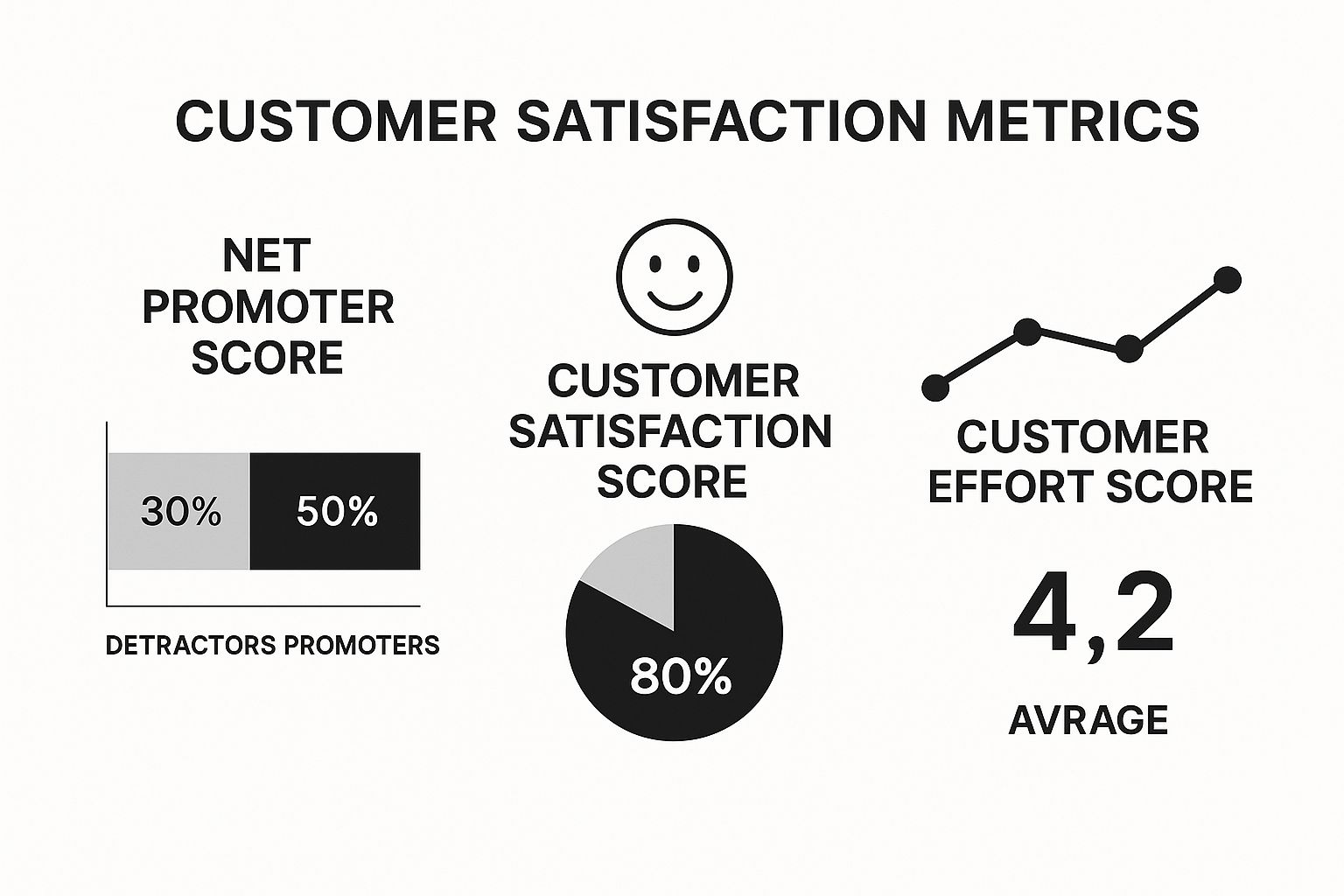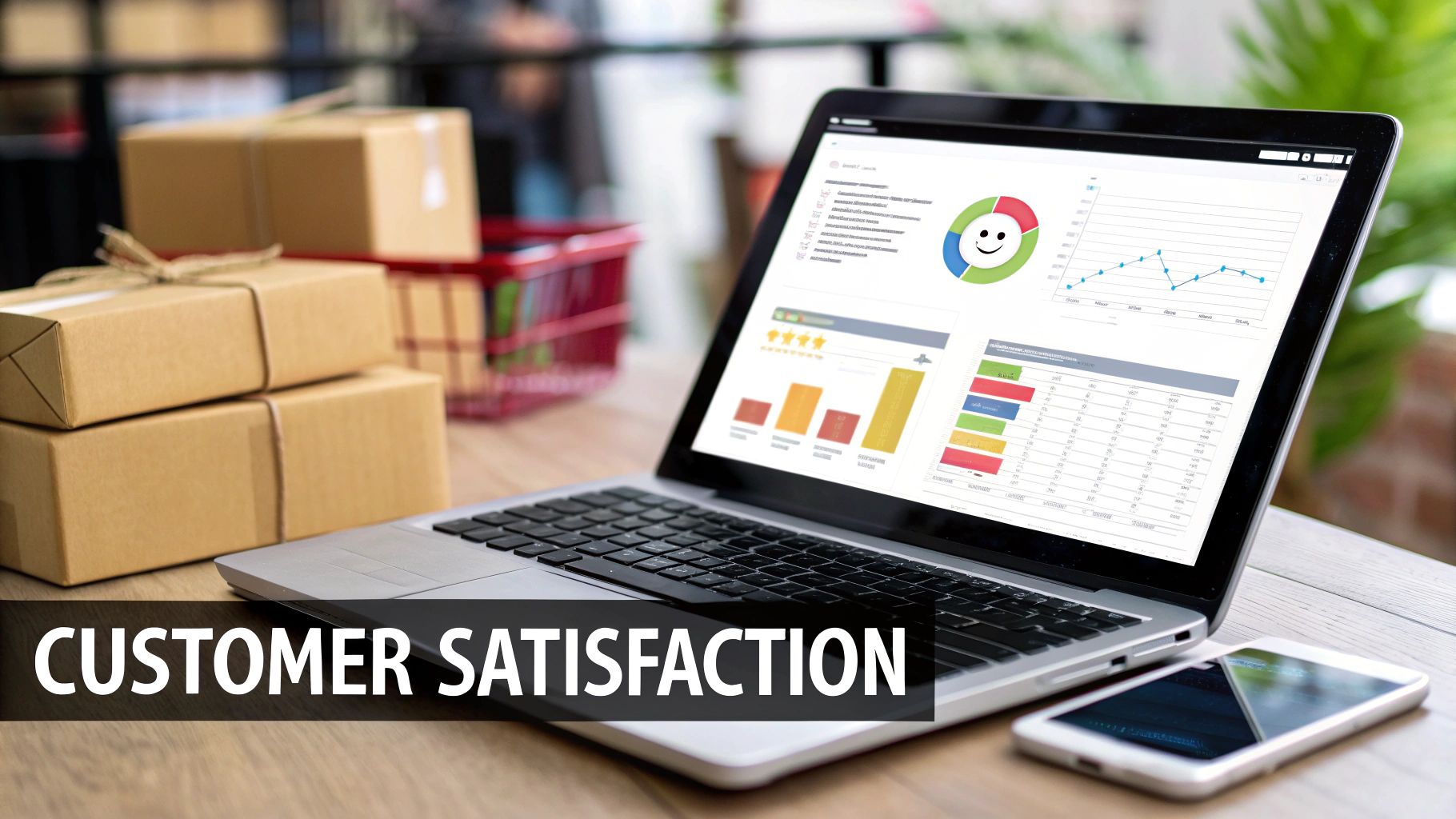Let's be blunt: you can't improve what you don't measure. In the cut-throat world of e-commerce, figuring out how to measure customer satisfaction isn't a "nice-to-have"—it's a critical business function. A common mistake we see is brands either not asking for feedback at all or using clunky email surveys that get ignored. The result? You're flying blind, leaving money on the table, and letting competitors solve the very problems your customers are having.
In this playbook, we'll give you a no-fluff, actionable guide. You'll learn exactly how to use simple, powerful metrics on channels your customers actually use (like WhatsApp) to get the insights you need to boost retention and drive real revenue growth.
Why Customer Satisfaction Is Your Most Important Metric

In e-commerce, you're not just selling products—you're selling an entire experience. From our experience with over 500 Shopify stores, we've seen firsthand that brands who actively track satisfaction see a direct and undeniable lift in repeat purchases and customer lifetime value (LTV). Knowing how to measure customer satisfaction isn't a vanity project; it's about monitoring the health of your business straight from the source.
The market statistics back this up. The global customer experience management market was valued at a massive $16.91 billion in 2023 and is projected to explode to $52.54 billion by 2030. That growth makes perfect sense when you learn that customers who have an exceptional experience spend 140% more than those who have a poor one. You can find more compelling data in Sprinklr's customer experience research.
Here’s the unfiltered truth from the trenches: Your customers will tell you exactly what’s working and what’s broken—if you just give them an easy way to do it. A low score isn't a failure; it’s a free consultation on how to make your business better.
This guide is designed to cut through the academic jargon and give you a practical playbook. We won't just define metrics; we'll show you exactly how to implement them to get tangible results for your brand.
What You'll Learn
We're going to walk you through the entire process, step-by-step. By the end, you'll know:
- The most important satisfaction metrics that actually matter for e-commerce.
- How to collect feedback without ever annoying your customers.
- The best way to turn raw data into concrete actions that boost your bottom line.
We’ll dive deep into the essential key performance indicators for customer service and show you how to transform that feedback into a growth engine for your business. Let's get started.
How to Measure Customer Satisfaction: Choosing the Right Metrics
If you're trying to figure out how to measure customer satisfaction, the most important thing is to keep it simple. From our experience with over 500 Shopify stores, we can tell you that focusing on a few core metrics delivers the clearest, most actionable insights. Don't fall into the trap of measuring everything at once—that’s just a fast track to data overload and confusion.
A common mistake we see is brands using the wrong metric at the wrong time. You wouldn’t ask a customer about their lifelong loyalty to your brand right after a single support chat. It just doesn't fit.
So, let's break down the "Big Three" and show you exactly where and when to use them for maximum impact.
The Big Three Customer Satisfaction Metrics
These three metrics are the foundation of any solid customer feedback program. Each one answers a different, but equally crucial, question about your customer's experience.
Customer Satisfaction Score (CSAT): This is your in-the-moment check-in. It simply asks, "How satisfied were you with this specific interaction?" It’s perfect for getting immediate feedback right after a purchase, a support chat on WhatsApp, or a product delivery. You're measuring satisfaction with a single transaction or event.
Net Promoter Score (NPS): This is all about measuring long-term loyalty. The question is, "How likely are you to recommend our brand to a friend?" NPS gives you a high-level view of your overall brand health and customer relationships. You should deploy it periodically, say 30 days after a purchase, not after every interaction.
Customer Effort Score (CES): This metric gets to the heart of a major loyalty driver: ease. It asks, "How easy was it to get your issue resolved?" A low-effort experience is a powerful indicator of future loyalty. CES is incredibly valuable to use after a customer interacts with your help center or navigates your returns process.
This dashboard visual gives you a great real-world look at how these metrics come together.

You can see how each score provides a unique lens. CSAT tells you about immediate happiness, while NPS clues you into long-term brand advocacy.
CSAT vs NPS vs CES: A Practical Comparison
To make it even clearer, we've put together a quick comparison table. This breaks down the key differences to help you decide which metric is the best fit for specific touchpoints in your customer's journey.
Using this table as a guide ensures you're always asking the right question at the right time, which is the secret to getting feedback you can actually use.
Deploying Metrics with Precision
The strategy that consistently delivers the best results for our clients is mapping each metric to a specific touchpoint in the customer journey. You have to be intentional.
Our Pro Tip: Start with CSAT. It's the easiest to implement and gives you immediate, high-value feedback on your day-to-day operations. A fantastic starting point is to trigger a simple CSAT survey via WhatsApp right after a customer service chat is closed.
This structured approach to measurement isn't just a modern trend; it's a scientifically validated practice. The American Customer Satisfaction Index (ACSI), established way back in 1994, uses a rigorous model to connect satisfaction scores directly to business outcomes like loyalty and profitability. Major industries have relied on this for decades. You can explore the ACSI model's impact and see how top companies use this data.
Ultimately, choosing the right metric for the right moment is how you get clear signals from your customers, not just more noise.
Collecting Feedback Without Annoying Your Customers

Let's be honest. The biggest challenge for most e-commerce brands isn't picking the right satisfaction metric. It's actually getting customers to respond. Your brilliant survey is useless if it just collects dust in an email inbox.
Traditional email surveys are fighting a losing battle against spam filters, overflowing inboxes, and banner blindness. There’s a much better way. The secret is to meet your customers where they already are: WhatsApp.
With an incredible 98% open rate, WhatsApp blows every other channel out of the water for gathering instant feedback. As an official Meta Business Partner, we can tell you it's direct, personal, and cuts straight through the noise. If you're serious about figuring out how to measure customer satisfaction, this is where the real conversations are happening.
Designing a Frictionless WhatsApp Survey
The magic of using WhatsApp is keeping things conversational and simple. A customer should be able to give you feedback with a single tap. Don't send them to an external link or make them fill out a long form. That friction is a response-rate killer.
From our experience with over 500 Shopify stores, the most effective strategy is to trigger an automated message right after a critical moment in the customer journey:
- Right after delivery confirmation: "Hey [Name], how was your delivery experience?"
- Minutes after closing a support ticket: "How did our team do today?"
- A few hours post-purchase: "Loving your new [Product Name]?"
This immediacy is key. The experience is fresh in their mind, which means you get more accurate, gut-level feedback.
Timing Your Surveys to Maximize Responses
Getting the timing right is crucial, but so is the frequency. Bombarding customers with requests is the fastest way to get your number blocked. You need a thoughtful strategy that respects their time.
Here's a real-world example from a brand we work with: We helped a fashion brand getting almost no replies to their email surveys. We set up a simple automated flow using Kanal. Now, as soon as an order is marked "Delivered" in Shopify, a CSAT survey is sent via WhatsApp. Their results were staggering—they jumped from a 3% email response rate to a 35% response rate on WhatsApp in the first month.
This targeted, timely approach turns feedback collection into a real-time conversation. You’re not just gathering data points; you're building a relationship. After all, understanding the importance of customer reviews is a core part of this, as each review is a piece of the satisfaction puzzle.
Your goal is to make every message feel personal. Use the customer's first name, mention their specific order, and keep the tone friendly. With a platform like Kanal, you can use our drag-and-drop flow builder to create these conversational surveys in minutes—no coding needed. This makes giving feedback feel less like a task and more like a quick, helpful chat.
Turning Customer Feedback into Action and Revenue
https://www.youtube.com/embed/QgMBmU4fqYs
Collecting customer satisfaction data is a great start, but it's only half the job. From what we’ve seen time and again, the biggest mistake brands make is letting that feedback gather dust. That data is a goldmine, but it's worthless if you don't act on it. This is where you turn simple insights into immediate, revenue-driving action.
The secret is creating automated "feedback loops." It’s a straightforward concept: a customer's survey response should instantly trigger a relevant, personalized follow-up. This is about closing the loop in real-time and proving to your customers that you're genuinely listening.
Building Automated Feedback Loops
Picture this: a customer gives you a low CSAT score right after a purchase. The old way was for someone to maybe look at it at the end of the month. The smart, effective way is to use that score as an instant trigger for action.
Here’s a practical breakdown of how this works in Kanal:
- A low score (e.g., 1 or 2 out of 5): This is your cue to jump in. The system can automatically tag the customer and create a high-priority ticket for an agent. That agent can then reach out personally on WhatsApp to find out what went wrong and make it right.
- A high score (e.g., 4 or 5 out of 5): Don't let this moment pass! This is a golden opportunity. You can automatically send a thank-you message with a small discount for their next purchase or ask them to leave a public review on a site like Trustpilot.
This simple automation transforms a survey from a passive measurement tool into a powerful engine for customer retention and reputation management.
Real-World Example: We work with a fast-growing beauty brand that put this exact strategy into play. Whenever a customer gave a high CSAT score, they automatically received a "thank you" offer for 15% off their next order. By simply acting on positive feedback, they increased their repeat purchase rate by 18% in just three months. That's the power of closing the loop.
Turning Satisfaction into Loyalty and Advocacy
Acting on feedback is about more than just damage control; it's a core part of building lasting relationships. When you reward happy customers, you reinforce their positive feelings and give them a compelling reason to come back. This is a foundational element of effective customer loyalty program ideas, turning one-time buyers into lifelong fans.
By responding to negative feedback quickly and with empathy, you can often turn a bad experience into a memorable, positive one. These automated loops are a perfect example of using technology to deliver a more human touch at scale. It shows you care enough to solve problems before they escalate.
Analyzing Results to Spot Trends and Opportunities

Once survey responses start rolling in, it's tempting to just look at the overall score. But the real value is in digging deeper to find the story behind the data. This is where you go from just collecting feedback to uncovering actionable business intelligence.
Your goal is to connect the dots. Do you notice a dip in CSAT scores every time you use a particular shipping carrier? Are your Net Promoter Scores tanking right after a major website update? Finding these correlations is like getting a treasure map that points directly to what you need to fix.
Segmenting Your Feedback for Deeper Insights
One of the most powerful things you can do is segment your feedback. An overall score gives you a bird's-eye view, but the game-changing insights are almost always found by slicing up the data.
Try looking at your feedback through different lenses:
- First-time vs. repeat customers: Are your loyal customers consistently happy, but new buyers are struggling?
- Product category: Is your apparel line getting rave reviews while your electronics have a lower satisfaction rate? This could point to a quality control issue.
- Geographic location: Are customers in one state complaining about shipping times?
- Discount vs. full-price buyers: Do customers who paid full price have different satisfaction levels?
A common mistake we see is brands lumping all their feedback together. By not segmenting, they miss the most critical patterns. We've seen brands with a decent overall CSAT of 75% who, after segmenting, discovered their highest-value customers were actually extremely unhappy. That’s a massive red flag for future churn.
This kind of detailed analysis is more important than ever because customer expectations are through the roof. In fact, HubSpot's research shows that the average CSAT score fell by over 11% between 2018 and 2022, down to about 73%. This reflects a new, much higher bar for service.
Connecting Satisfaction to E-Commerce Metrics
As an official Meta Business Partner, we constantly advise brands to connect their satisfaction data directly to their e-commerce metrics. This is how you demonstrate the real financial impact of customer happiness. When you integrate your survey data with platforms like Shopify, you can start answering powerful questions:
- What's the difference in Lifetime Value (LTV) between a "Promoter" (NPS 9-10) and a "Detractor" (NPS 0-6)?
- How does Average Order Value (AOV) compare for highly satisfied versus dissatisfied customers?
When you can confidently say that a 10-point bump in your NPS leads to a 15% increase in customer LTV, you’re no longer talking about vague feelings. You're talking about revenue. This is a vital part of any serious ecommerce funnel analysis and is what turns a feedback program from a simple expense into a genuine engine for growth.
Your Top Questions About Customer Satisfaction Answered
Even with a solid plan, questions always pop up. It's a journey, not a one-and-done task. Here are some of the most common questions we hear from e-commerce brands and our straight-up, experience-backed answers.
How Often Should I Actually Survey My Customers?
This is a classic question, and it's about finding the sweet spot where you get insights without annoying your customers. Nobody likes being bombarded.
The most effective approach we've seen is tying the survey type to a specific customer action.
For in-the-moment feedback (CSAT): You need to move fast. The best time to ask about a recent purchase or a support chat is right after it happens. The memory is fresh, and the feedback will be far more accurate.
For the big-picture view (NPS): This is about long-term loyalty, so you can be more measured. Sending an NPS survey every 3 to 6 months is a great rhythm. The key is to automate it so a customer who just gave CSAT feedback isn't immediately hit with an NPS request.
What’s a “Good” Score Anyway?
Everyone wants to know how they stack up. While scores can vary by industry, from our work with hundreds of brands, here are some solid benchmarks to aim for:
- CSAT (on a 1-5 scale): If you're hitting 4.0 or above, you're doing well.
- NPS (on its -100 to 100 scale): A score over 30 is good, anything past 50 is excellent, and 70+ is world-class.
Our advice: Don't get obsessed with a single number. The real magic is in the trend. Is your score consistently ticking upwards month after month? If so, you're winning. That upward trend means your efforts are paying off.
Can I Get Started Without Fancy Software?
Absolutely. You can dip your toes in the water with free tools like Google Forms. It's a great way to just get started.
The real challenge isn't building the survey—it's getting it in front of people and acting on the feedback. This is where a dedicated platform makes a world of difference. When we see clients switch from email surveys to integrated WhatsApp surveys with a tool like Kanal, response rates just explode. We're talking 10x increases.
Plus, the ability to automatically trigger follow-ups based on a customer's score is how you turn data collection into a growth engine. We talk a lot more about this in our guide on actionable marketing automation best practices.
What's the Single Biggest Mistake You See Brands Making?
From our experience with over 500 Shopify stores, we can tell you this without a doubt: the biggest mistake is asking for feedback and then doing absolutely nothing with it.
Honestly, it's worse than not asking at all.
Think about it. A customer takes time to tell you about a problem. When they're met with dead silence, you're screaming, "We don't actually care." You haven't just missed a chance to fix something; you've probably burned a bridge and lost that customer for good.
Always close the loop. Acknowledge their feedback, thank them, and let them know what you're doing about it. That's how you build trust and show you're a brand that genuinely listens.
Ready to stop guessing and start measuring what truly matters? By implementing these strategies, you’re not just learning how to measure customer satisfaction—you’re building a system for sustainable growth.
Ready to build your own high-converting feedback flows? Get a demo of Kanal today and see how top brands use WhatsApp to drive retention and revenue.



